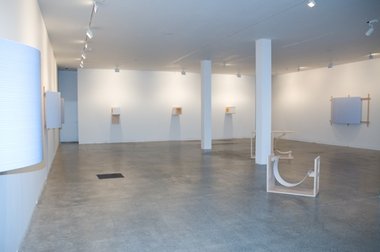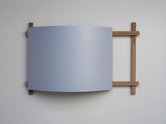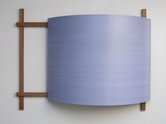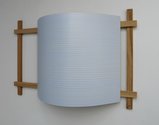John Hurrell – 31 August, 2010
Ivanoff's laminated plywood supports hint of Hiam Steinbach in their emphasis on the mechanics of display, using boxes instead of flat shelving, focusing on the method of transportation, handling and care - instead of merchandising - and so showing us the value of what is normally assumed or hidden. The ‘before' and ‘after' of each exhibition presentation becomes the subject matter of the ‘during', scrutinising how the works get to the exhibition space and how they leave.
In the large downstairs space at Two Rooms Noel Ivanoff has thirteen works, paintings that are also sculptures, artworks that seem to double as freighting crates - and which explore the concave and convex forms resulting from rolling up or bending works to fit them ‘safely’ into confined spaces.
The crates are not really self-contained or functional for transporting art, unlike say works by somebody like the Chilean artist Eugenio Dittborn who makes postable ‘itinerant’ art where cardboard and fabric envelopes fold open to be displayed on the walls as collaged and written-on paintings. Ivanoff’s plywood boxes or rectangular cedar constructions, while alluding to freight, aren’t used as such and seem also to be a metaphor for the artist’s studio (or artist’s imagination) from which the flexible painting is ‘sprung’ out into the world to actively engage with its new environs.
The physical tension of the curved painted plywood plane, straining and bulging yet held in place by braces and screws, is pretty palpable. With the show’s title, Skin Cradles, there is a suggestion not only of paint as acrylic film, but also of the epiderm of the artist himself, a symbol perhaps of a babylike mental vulnerability in a ‘cradle’.
Ivanoff shows three types of ‘painting’: the horizontal paintings on the wall, convex grey sheets with parallel ridges formed by the raised edges from brush strokes; the floor sculptures, smooth concave white sheets in open boxes; and polystyrene blocks attached to plywood and pine constructions - with elliptical holes cut out with a jigsaw, sections of the exposed cut surface painted in glowing cadmium yellow. These three varieties he explores with a wide range of permutations, much as Lewitt and Judd for example used to do with their signature cube and box forms.
Thus we get different proportions in the pressurised sheets, varied angles of projection and steepness of curve, different widths for the sheets across the ‘crate’ inner bases, and experiments in tone for the applied colour. The crate paintings look vaguely totemic while the bulging grey wall works remind you of translucent corrugated plastic or squat corrugated iron water tanks.
Ivanoff’s laminated plywood supports hint of Hiam Steinbach in their emphasis on the mechanics of display, using boxes instead of flat shelving, focusing on the method of transportation, handling and care - instead of merchandising - and so showing us the value of what is normally assumed or hidden. The ‘before’ and ‘after’ of each exhibition presentation becomes the subject matter of the ‘during’, scrutinising how the works get to the exhibition space and how they leave.
This theme of logistics has been explored by Ivanoff before with his ‘pallet-paintings’, where painted mdf panels were attached to pine pallets and placed on the gallery floor or wall. He has also made lined open crates and boxes. With these crates though, the theme of the art’s physical safety is focused on with greater intensity - their protection - and who ensures that.
John Hurrell









 Advertising in this column
Advertising in this column Two Rooms presents a program of residencies and projects
Two Rooms presents a program of residencies and projects



This Discussion has 0 comments.
Comment
Participate
Register to Participate.
Sign in
Sign in to an existing account.